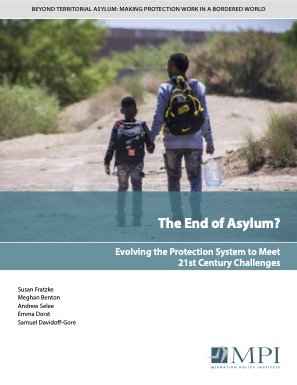By Susan Fratzke, Meghan Benton, Andrew Selee, Emma Dorst, Samuel Davidoff-Gore
The territorial asylum system at the heart of the global protection regime has proven itself to be a blunt tool with which to address the protection challenges of the 21st century. New crises, protracted displacement situations, and expanding norms about who merits protection have created a significant and growing population of individuals in need of international protection. In addition, growing mobility pressures due to demographic change, economic inequality, and climate change have found an outlet in asylum systems, providing an avenue of entry even for those who do not technically qualify for protection. Meanwhile, national governments have struggled to reconcile their international protection responsibilities with their domestic responsibilities to maintain security and order and to foster public trust. Asylum adjudication systems have become unwieldy and unable to keep pace with the demands placed on them, particularly when confronted with rapid changes or complex needs. These failures have had serious consequences. For individuals, the absence of large-scale alternatives to territorial asylum means that access to protection often depends on taking extreme risks or enduring hardships in order to reach the territory of a country where they can seek protection, journeys that may not be possible for the most vulnerable. For states, territorial asylum places governments in a largely reactive position, only responding to protection needs once their hand is forced by the arrival of people seeking protection on their territory. And at the global level, the lack of tools to facilitate the legal mobility of individuals in search of protection and of opportunities for displaced persons to move to a country other than their country of first asylum has concentrated protection responsibilities in a small number of countries, most of them low- or middle income. According to estimates by the United Nations High Commissioner for Refugees (UNHCR) nearly 40 percent of the world’s refugees and individuals in refugee-like situations were hosted by just five countries as of mid-2023. To answer these challenges, there is an urgent need to shift the focus of protection responses away from an exclusive reliance on territorial asylum and toward a diversified set of policy tools. Territorial asylum will, and should, remain accessible as a safety valve, but states should seek to proactively facilitate access to protection as soon after and close to a displacement crisis as possible—and well before dangerous journeys become necessary. At the same time, policy approaches should recognize the agency of refugees and displaced persons—and the mobility pressures this can create—and provide legal avenues for individuals to move within and outside of their country of first asylum to join family and other connections through family reunification or sponsorship channels and to pursue education, work, or other opportunities. Aside from the benefits for displaced persons, such approaches would help transit and destination countries to reduce disorder at their borders and, by capitalizing on the resiliency and resourcefulness of displaced individuals in locating and securing solutions for themselves, to better allocate scarce resources to assist those who are most vulnerable. Policy approaches should also be responsive to the specificities of each crisis or situation. This may mean adopting expedited procedures or flexible forms of status in order to enable faster access to status, prevent processing backlogs, or respond to legitimate needs that are not recognized in existing legal frameworks.
Washington, DC: Migration Policy Institute, 2024. 33p.





